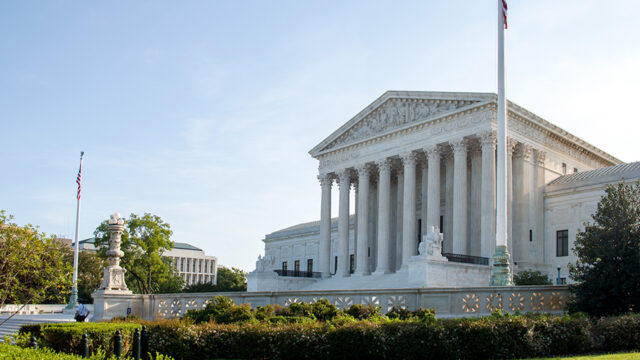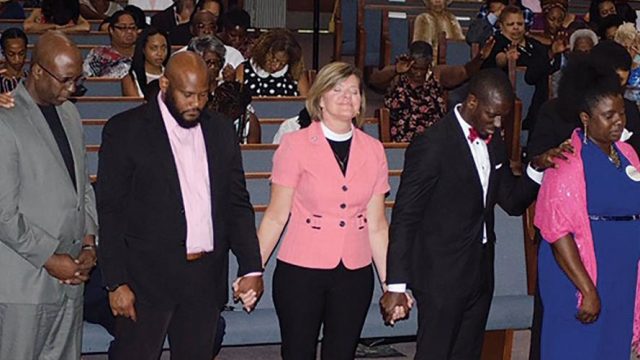The pronouncement in Revelation 22:11 is God’s assurance that He will take care of His people.

The expression “time of trouble” (Hebrew cet tsarah/tsar) appears eight times in the Old Testament.1 The New Testament equivalent “great tribulation” (thlipsis megalē) appears three2 times. In each text the “time of trouble/tribulation” refers to a time of distress, oppression, disaster, or war.
Considering the biblical prophetic outline, we believe that we are living in the time of the end just prior to the second coming of Jesus. Thus, the great time of trouble is not a time far off in the future, but a time we may all experience. After all, Ellen White noted: “The final movements will be rapid ones.”3 While persecution is to be expected during the great time of trouble, already now Christians are persecuted, and, in fact, Christians are currently one of the most persecuted religious groups in the world.4
Especially in regions with traditionally non-Christian majority religions, Christians have experienced severe persecution, including the destruction and burning of houses of worship, severe beatings, destruction of property, and even death. While persecution will be a reality in the time of the end, Scripture assures us that during the great time of trouble none of God’s people will lose their lives, because God will take care of them (Rev. 22:11).5 Let’s look more closely at the biblical data that help us understand the concept of a “time of trouble.”
Jeremiah’s Witness
Of special interest are three texts in Jeremiah. The prophet lived during the last decades of the kingdom of Judah. The last good king of Judah, Josiah, died in 609 B.C. in the battle at Megiddo against the Egyptians. His sons did not follow in the footsteps of their father, and Jeremiah repeatedly warned them of the coming time of trouble unless they returned to their God. The trouble on the horizon at that time was the Babylonian Empire.
The drought in Jeremiah 14 is seen as a precursor of the coming judgment. Jeremiah pleads with God, “O you hope of Israel, its savior in time of trouble” (verse 8), “do not leave us” (verse 9).6 Jeremiah 15 includes God’s negative response to Jeremiah’s plea. A time of trouble will come (verse 11), and “your wealth and your treasures I will give as spoil, without price, for all your sins” (verse 13).
The Book of Consolation (Jer. 30-33) opens with a promise that sometime in the future Israel and Judah would return from exile to their homeland, the land of their forefathers (Jer. 30:3). The northern kingdom, Israel, had already gone into the Assyrian exile in 722 B.C.; and Judah was soon to follow in three deportations (in 605, 597, and 586 B.C., respectively) to Babylon. But prior to the exile there would be the horror of the conquest of Jerusalem by the Babylonians. “For that day [of judgment] is great, so that none is like it; and it is the time of Jacob’s trouble” (verse 7, NKJV). Jeremiah describes the events surrounding the fall of Jerusalem in 586 B.C., that included a months-long siege of the city, and the Babylonians pillaging the city and destroying the first temple, as the time of Jacob’s trouble. This was the historical fulfillment of the prophecy concerning “the time of Jacob’s trouble.” Nevertheless, Judah “shall be saved out of it” (verse 7). Following the Babylonian exile, the people were returned to the land of Judah.
Insights From Daniel and Matthew
The best-known “time of trouble” text in the Old Testament is found in Daniel 12:1: “At that time shall arise Michael, the great prince who has charge of your people. And there shall be a time of trouble, such as never has been since there was a nation till that time. But at that time your people shall be delivered, everyone whose name shall be found written in the book.”
“At that time” refers back to when the king of the north comes to “his end, with none to help him” (Dan. 11:45). That is the time Michael shall stand up. Michael, whose name means “Who is like God?” is the great prince who stands guard over Daniel’s people (Dan. 12:1). In Jude 9 he is called “the Archangel,” and in 1 Thessalonians 4:16 the voice of the Archangel will raise the dead in Christ. Because in John 5:26-28 Christ says His voice will raise the dead, the term “Michael the Archangel” refers to Christ.
The Hebrew word camad, “stand up, arise,” is repeatedly used in Daniel 11, where it always refers to a new king coming to power.7 All the kings in Daniel 11 were earthly rulers, “but now the ruler from heaven will take over, and He will make up a very different type of kingdom, one that is ruled upon the principles of righteousness.”8
A time of trouble “such as never has been since there was a nation till that time” is also mentioned in Matthew 24:21, “For then there will be great tribulation, such as has not been from the beginning of the world until now, no, and never will be.” Both “times” are referred to as the greatest in human history. Since the two statements refer to different times, they cannot both be literally true. Therefore, they must be understood as idiomatic expressions that emphasize the superlative nature of the events.9
That Daniel’s time of trouble comes at the end of world history, just prior to the Second Coming is indicated in the next two sentences: “But at that time your people shall be delivered, everyone whose name shall be found written in the book. And many of those who sleep in the dust of the earth shall awake, some to everlasting life, and some to shame and everlasting contempt” (Dan. 12:2). While during the great time of trouble God’s people will experience persecution and hardship, God will deliver His people from the designs of their enemies, so that they, together with the resurrected righteous, shall be caught up together “in the clouds to meet the Lord in the air” (1 Thess. 4:17).
The “great tribulation” Jesus predicted in Matthew 24:21 follows the fall of Jerusalem in A.D. 70, described in verses 15-20. Thus, the great tribulation in verse 21, following the fall of Jerusalem, found a fulfillment during the Dark Ages when Satan tried to destroy God’s true people through the apostate church.
The Time of Trouble in the Book of Revelation
In Revelation 7:4 John hears the number of those who were sealed: 144,000. In verse 9 he sees them and, behold, they are “a great multitude that no one could number, from every nation, from all tribes and peoples and languages, standing before the throne and before the Lamb.” When he is wondering who they are, he is told: “These are the ones coming out of the great tribulation. They have washed their robes and made them white in the blood of the Lamb” (Rev. 7:14). This is the only reference to the great tribulation at the time of the end in the book of Revelation, but what happens during this time is described in Revelation 13:15-17 and chapters 15 and 16. This great tribulation is the same event as the time of trouble referenced in Daniel 12:1.
Just as in the epilogue to the book of Daniel, where Daniel is told that the unsealing of his prophecies will cause a division, “many shall purify themselves and make themselves white and be refined, but the wicked shall act wickedly. And none of the wicked shall understand, but those who are wise shall understand” (Dan. 12:10), so in the epilogue to the book of Revelation (Rev. 22:621) the solemn announcement is made: “He who is unjust, let him be unjust still; he who is filthy, let him be filthy still; he who is righteous, let him be righteous still; he who is holy, let him be holy still” (verse 11, NKJV). Human beings “can resist the gospel for a time. Eventually a verdict will be pronounced, however, and it will be too late to change.”10
The great time of trouble will start with the close of probation in Revelation 22:11, when Jesus finishes His ministry of intercession and pre-Advent judgment in the heavenly sanctuary. At that time, only two classes of people will be found on earth: those who have accepted God’s offer of salvation, and those who have rejected it. As mentioned above, during the great time of trouble, when the seven last plagues are poured out on the wicked, God’s people are without an Intercessor in heaven, but they are not forsaken by God. While the Holy Spirit is withdrawn from the wicked, He is not withdrawn from God’s people. Furthermore, the pronouncement in Revelation 22:11 is God’s assurance that He will take care of His people. “He who is holy, let him be holy still” means God guarantees He will protect them, and nothing will happen to them to change their destiny; they will remain holy. Yes, they will experience the “time of Jacob’s trouble,” but not one of God’s holy ones will be lost.
The Time of Trouble in the Writings of Ellen White
Ellen White outlined three distinct time periods in her description of end-time events, each with specific happenings: (1) the time of the investigative or pre-Advent judgment, which concludes with the close of probation; (2) the great time of trouble following the close of probation and concluding with the Second Advent; (3) the millennium following the Second Advent, concluding with the resurrection of the wicked and their final destruction in the lake of fire.
Events leading up to the time of trouble include the sealing of the saints,11 the latter rain,12 the loud cry,13 the shaking,14 the Sunday laws,15 the death decree,16 and the close of probation.17 Following the close of probation Ellen White saw the great time of trouble, the outpouring of the seven last plagues, and the time of Jacob’s trouble. This great time of trouble climaxes in the battle of Armageddon during the sixth plague, followed by a partial resurrection on the day of the second advent of Christ, at which time the first resurrection and the translation of the righteous takes place. These events will be followed by the millennium.
1. The Great Time of Trouble
The great time of trouble (Dan. 12:1) begins with the close of probation. It is the time when the seven last plagues will fall on the earth. God’s long-suffering has ended. The wicked have passed the boundary of their probation, and the Spirit of God has at last been withdrawn. “It was impossible for the plagues to be poured out while Jesus officiated in the sanctuary; but as His work there is finished, and His intercession closes, there is nothing to stay the wrath of God.”18 This is the time when the four angels in Revelation 7:1-3 loose the winds of the earth, and Satan will “plunge the inhabitants of the earth into one great, final trouble.”19
The seven last plagues20 will be of short duration and localized in various places around the globe, otherwise “the inhabitants . . . would be wholly cut off,”21 but the sixth plague will involve the worldwide battle of Armageddon in Revelation 16:12-16. The three unclean spirits (i.e., spirits of demons) come out of the mouth of the dragon (spiritualism), the beast (the Papacy), and the false prophet (apostate Protestantism). They arm the powers of this world to a final battle against God and His people. Armageddon is not a place in the Middle East, as many Christians believe, but wherever God’s people are endangered by the enemy— there is Armageddon. At the time of their greatest danger, however, Jesus appears in the clouds of heaven to rescue His people.22
2. The Time of Jacob’s Trouble
The fulfillment of the time of Jacob’s trouble, referred to in Jeremiah 30:7, in the time of Jeremiah, has been explained above. Ellen White applies the time of Jacob’s trouble to the time of the end and connects its beginning to the death decree before the close of probation, even though it occupies most of the time of the great time of trouble. “When this time of trouble comes, every case is decided; there is no longer probation, no longer mercy for the impenitent. The seal of the living God is upon His people. . . . The decree has been passed by the highest earthly authority that they shall worship the beast and receive his mark under pain of persecution and death.”23
As Jacob, though he had confessed his sins, still wrestled with God (Gen. 32), so God’s people will experience a time of anguish and feel a deep sense of their unworthiness. However, “their sins have gone beforehand to judgment and have been blotted out, and they cannot bring them to remembrance.”24
3. Partial Resurrection
Just before the appearance of Christ in the clouds of heaven there is a partial resurrection, as suggested in Daniel 12:2: “And many of those who sleep in the dust of the earth shall awake, some to everlasting life, and some to shame and everlasting contempt.” Ellen White describes this as follows: “All who have died in the faith of the third angel’s message come forth from the tomb glorified, to hear God’s covenant of peace with those who have kept His law. ‘They also which pierced him’ (Rev. 1:7, KJV), those that mocked and derided Christ’s dying agonies, and the most violent opposers of His truth and His people, are raised to behold Him in His glory and to see the honor placed upon the loyal and obedient.”25 This special resurrection does not take place days or weeks prior to the Second Coming, but on the day Jesus returns to this earth. Because the purpose of this resurrection is to let the people mentioned above see Him coming in the clouds of heaven, this special resurrection may be only minutes or hours prior to His appearing.
4. The Second Coming
When Christ comes, the first resurrection takes place (Rev. 20:4, 5). “The voice of the Son of God calls forth the sleeping saints. He looks upon the graves of the righteous, then, raising His hands to heaven, He cries: ‘Awake, awake, awake, ye that sleep in the dust, and arise!’ Throughout the length and breadth of the earth the dead shall hear that voice, and they that hear shall live.”26 The living who have accepted Jesus as their Saviour will be translated “in a moment, in the twinkling of an eye” (1 Cor. 15:52). “Now they are made immortal and with the risen saints are caught up to meet their Lord in the air,”27 and the unbelievers will be destroyed. “At the coming of Christ the wicked are blotted from the face of the whole earth—consumed with the spirit of His mouth and destroyed by the brightness28 of His glory.” At that time the millennium will commence.
We Have This Hope
We are clearly living in the time of the end (Dan. 11:45). Scripture and the Spirit of Prophecy provide us with a glimpse of the future. There will come persecution, a death decree, and the great time of trouble, during which God’s people have to live without an Intercessor in heaven. Nevertheless, they have nothing to fear, for God promised in Revelation 22:11 that He will take care of them. We can look with confidence into the future, knowing that Jesus will come to take us home to the mansions He has prepared for us (John 14:1-3).
1 Neh. 9:27; Job 38:23; Ps. 37:39; Isa. 33:2; Jer. 14:8; 15:11; 30:7; and Dan. 12:1.
2 Matt. 24:21; Rev. 2:22; 7:14.
3 Ellen G. White, Testimonies for the Church (Mountain View, Calif.: Pacific Press Pub. Assn., 1948), vol. 9, p. 11.
4 Kelly James Clark, “The Most Persecuted Religion in the World,” Huffpost, Mar. 6, 2013, available online at https://www.huffpost. com/entry/christianity-most-persecuted-religion_b_2402644?guce_referrer_us=aHR0cHM6Ly9mci5nYXRlc3RvbmVpbnN0aXR1dGUub3JnLzEzNzQyL3NpbGVuY2UtcGFwZS1wZXJzZWN1dGlvbi1jaHJldGllbnM&guce_referrer_cs=-lJOy8zbexdIzSumsz7IQQ. See also, in more detail, Rupert Short, Christianophobia (London: Civitas: Institute for the Study of Civil Society, 2012), available at https:// www.civitas.org.uk/pdf/Shortt_Christianophobia.pdf.
5 This assertion is based on Revelation 22:11. Its particular meaning is discussed in the section dealing with the time of trouble in the book of Revelation.
6 Unless otherwise indicated, all Bible texts are from The Holy Bible, English Standard Version, copyright © 2001 by Crossway Bibles, a division of Good News Publishers. Used by permission. All rights reserved.
7 Dan. 11:2, 3, 4, 7, 20, 21.
8 William Shea, Daniel: A Reader’s Guide (Nampa, Idaho: Pacific Press Pub. Assn., 2005), p. 269.
9 This is similar to the idiomatic expression in 2 Kings 18:5 and 23:25, where the kings Hezekiah and Josiah are both described as so faithful to the Lord that “after him was none like him among all the kings of Judah, nor who were before him.”
10 Ranko Stefanovic, Revelation of Jesus Christ, rev. Ed. (Berrien Springs, Mich.: Andrews University Press, 2009), p. 619.
11 Ellen G. White, Early Writings (Washington, D.C.: Review and Herald Pub. Assn., 1882,1945), p. 58.
12 Ellen G. White, The Acts of the Apostles (Mountain View, Calif.: Pacific Press Pub. Assn., 1911), pp. 54, 55.
13 Ellen G. White, Selected Messages (Washington, D.C.: Review and Herald Pub. Assn., 1958, 1980), book 1, p. 363.
14 E. G. White, Early Writings, p. 270.
15 E. G. White, Testimonies for the Church, vol. 9, p. 232.
16 Ellen G. White, The Great Controversy (Mountain View, Calif.: Pacific Press Pub. Assn., 1911), p. 631. On the timing of the death.
17 Ibid., p. 629.
18 E. G. White, Early Writings, p. 280.
19 E. G. White, The Great Controversy, p. 614.
20 The name “the seven last plagues” comes from the fact that when the 10 plagues fell on Egypt, the first three fell also upon the Israelites; only the last seven fell on the Egyptians alone. The last seven plagues in the time of the end will fall only on the wicked, not on the righteous.
21 E. G. White, The Great Controversy, pp. 628, 629.
22 E. G. White, Early Writings, pp. 284, 285.
23 E. G. White, Testimonies for the Church, vol. 5, p. 213.
24 E. G. White, The Great Controversy, pp. 620.
25 Ibid., p. 637.
26 Ibid., p. 644.
27 Ibid., p. 645.
28 Ibid., p. 657; cf. Rev. 19:11-21.








